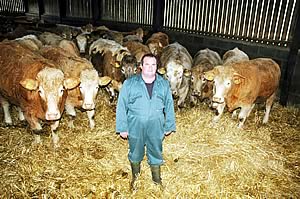07/05/08
Swapping global warming for global food crisis at the top of the news agenda has aroused a degree of optimism among livestock farmers, including Alastair Nixon who currently finishes 150 head of Charolais cross cattle a year.
Alastair Nixon
 |
Global influences have led to a hike in market prices for beef in the last few weeks, a trend that is none other but welcome, says Alastair Nixon.
“I believe we’re on the cusp of change and, after being ignored by government for more than 10 years, politicians are beginning to recognise our role, not only as managers of the environment, but also as food producers.
“As exporting beef countries seek to secure their own food supplies, there could in future be a greater opportunity for us to fill the shelves which would put a new bottom in the marketplace,” said Mr Nixon, who farms Swinhoe, 1,300 acre mixed holding near Belford, Northumberland in partnership with his wife, Valerie and parents, Martin and Helen, while daughter, Claire manages Swinhoe Farm Riding Centre.
“In the meantime however, we have a number of issues to address which evolve around escalating feed, fertiliser and energy costs, and ultimately, succession.”
Swinhoe Farm carries a 600 ewe flock complemented by a herd of 150 suckler cows, with two thirds spring calving and the remainder autumn.
As far as the beef enterprise is concerned, the Nixons are focused on exploiting its potential.
For 25 years, Charolais has been used as the herd’s terminal sire over their continental cross cows and heifers, and nowadays these bulls are selected from within the breed’s top 10% on performance data. Both bulls and replacement heifers are sourced from herds of known disease status.
“We finish our Charolais cross steers at an average 20 months and 380kg deadweight, and heifers, 320kg deadweight at 18 months. We’ve found they leave a margin higher than any of the other Continental terminal sires we’ve used, simply because they achieve greater weight for age, an average 50kg more, and the vast majority grade in R4L bracket or better,” he said.
“Using Charolais as a terminal sire has not incurred many calving difficulties, unlike those we’ve experienced using other continental bulls. The calves are lively and soon up and away suckling. We also rate their temperament – they’re quiet to handle which is a bonus as labour becomes increasingly scarce.
“In addition, the cattle tend to grow uniformly, so when it comes to marketing we are able to batch them up easily, and they’re accompanied by that characteristic colour hallmark.”
All cattle born and reared at Swinhoe have been taken through to finishing using home grown feed fed in a total mixed ration based on grass silage and cereals.
“It’s a strategy we’ve firmly believed in - it cuts out the extra hauls to market and back, the market commission and the accompanying stress on the beasts,” he said.
“However, escalating feed, fertiliser and energy costs are forcing us to reconsider our marketing strategy. We need an absolute minimum of £3.50/kg deadweight, just to cover costs, never mind any surplus for reinvestment in accommodation, or new equipment.
“Finished cattle prices are well over the 130p/kg liveweight mark in the local ring, around the same figure we received in 1996 when grain was trading at £100/tonne, and fertiliser price has increased three fold in the last 18 months.
“So, we have one or two options. The last couple of years has seen a strong store market prompting us to consider selling our cattle at an average 12 months, which would in turn enable us to stock more cows; alternatively we could introduce a more extensive stocking regime enabling us to cut back on fertiliser.
“We have recently taken on another 150 acres of grassland which would enable us to half our current stocking rate to one cow per two acres,” Mr Nixon said.
The future of the beef enterprise at both Swinhoe and for the industry at large is dependent on two major factors, he says.
“Firstly on the marketplace; without any guaranteed payments after 2012, we will have to receive a major price rise, just to cover production costs.
“Secondly, the next generation; our knowledge base is fast disappearing; there are very few young people who have the specialist skills and knowledge to rear live stock properly, and with the average age of farmers standing at 57 years, something desperately needs to happen in the next five to 10 years to ensure succession of the livestock industry.”
 Bright Future for Charolais Cross Beef Enterprise Bright Future for Charolais Cross Beef Enterprise
 Roofed Midden Brings Benefits All Round Roofed Midden Brings Benefits All Round
 New Cattle Shed Improves Viability of Lake District Farm New Cattle Shed Improves Viability of Lake District Farm
|



